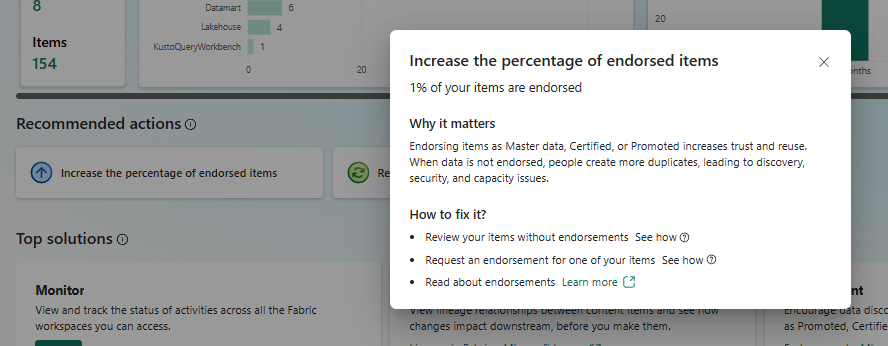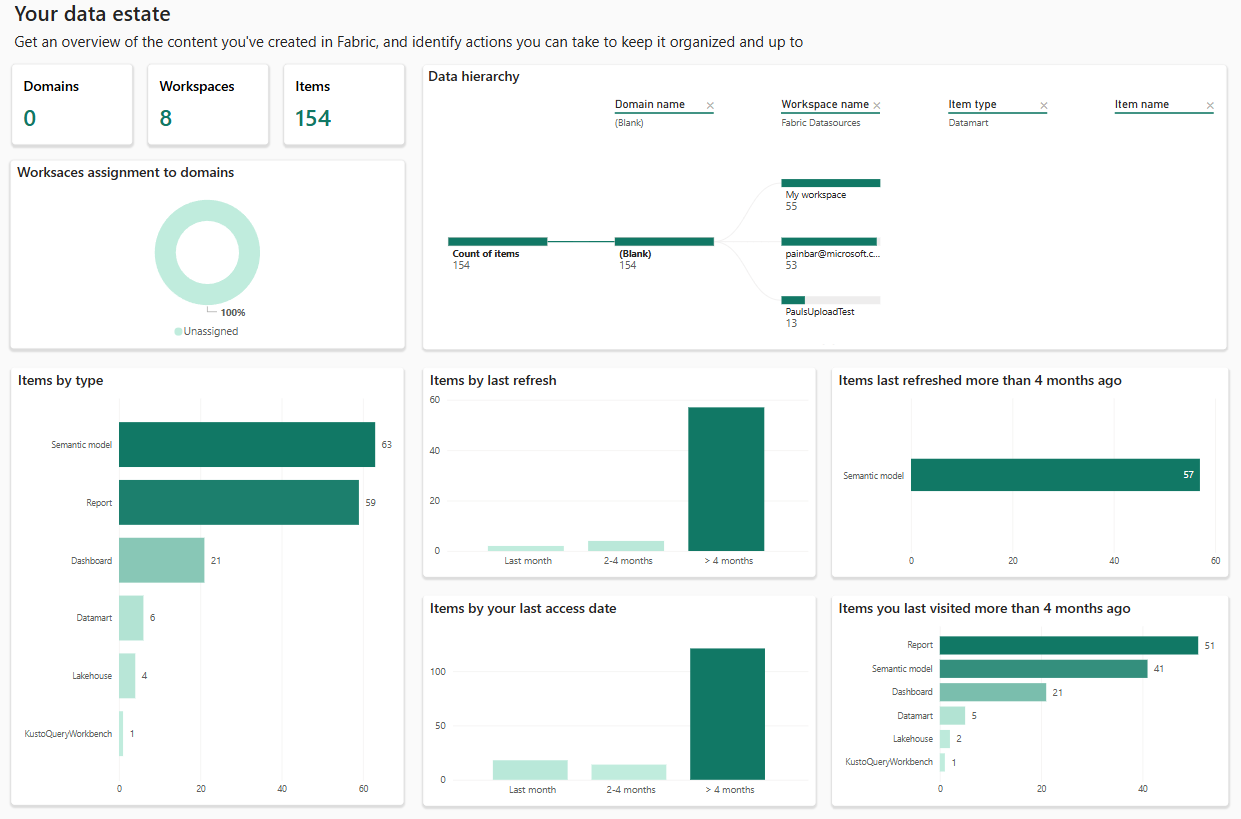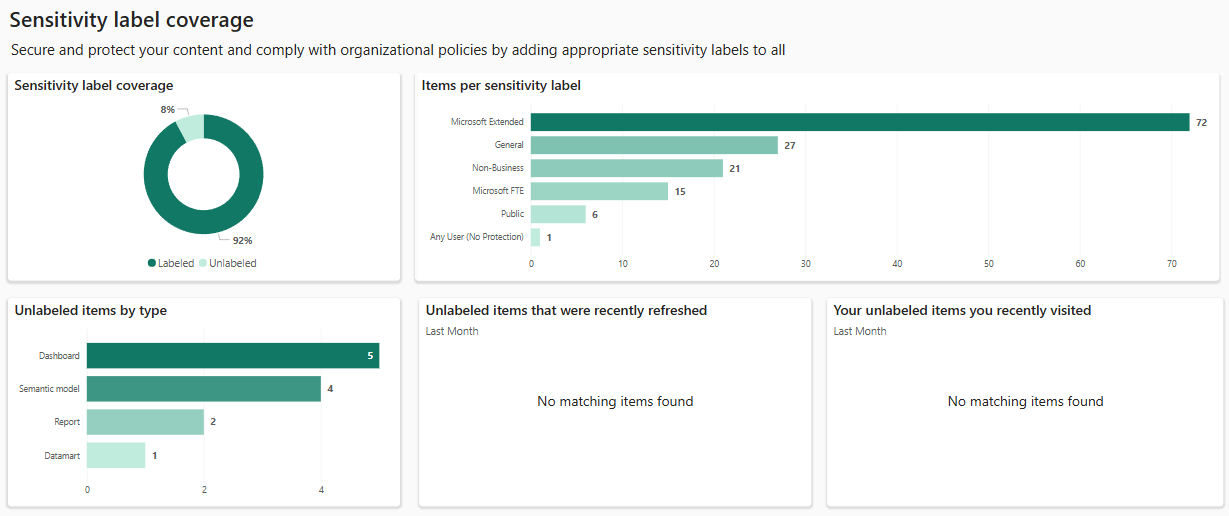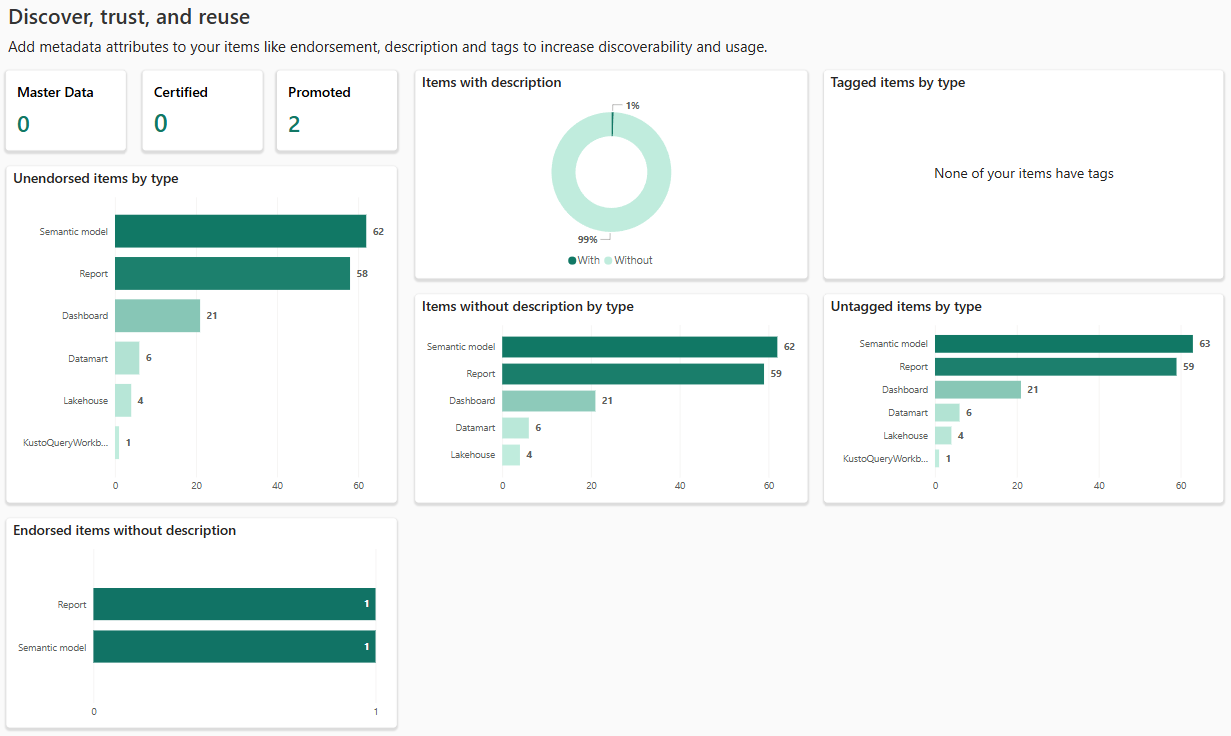ควบคุมข้อมูล Fabric ของคุณ
แท็บควบคุมของแค็ตตาล็อก OneLake ช่วยให้คุณวิเคราะห์ ปรับปรุง และตรวจสอบท่าทางการกํากับดูแลของข้อมูลที่คุณเป็นเจ้าของทั่ว Fabric ซึ่งรวมศูนย์ไว้ในที่เดียว:
ข้อมูลเชิงลึก ที่ช่วยให้คุณเข้าใจสถานะการกํากับดูแลของข้อมูลของคุณ และระบุพื้นที่สําหรับการปรับปรุง
การดําเนินการที่แนะนํา คุณสามารถใช้เพื่อปรับปรุงท่าทางการกํากับดูแลของข้อมูลของคุณ การดําเนินการที่แนะนําจะมาพร้อมกับคําแนะนําเพื่อช่วยให้คุณทําสิ่งเหล่านั้นให้สําเร็จ
ลิงก์ไปยังเครื่องมือและทรัพยากรการเรียนรู้ คุณสามารถใช้เพื่อช่วยให้คุณวิเคราะห์ ปรับปรุง และรักษาการกํากับดูแลของข้อมูลที่คุณเป็นเจ้าของใน Fabric
ข้อมูลเชิงลึกที่คุณเห็นในแท็บควบคุมนั้นยึดตามรายการทั้งหมดใน Fabric ที่คุณเป็นเจ้าของ รายการเหล่านี้คือรายการที่อาจปรากฏขึ้นเมื่อคุณนํา รายการของฉัน ตัวกรองบนแท็บสํารวจ (ดู ข้อควรพิจารณาและขีดจํากัดของ สําหรับข้อยกเว้น)
ในครั้งแรกที่คุณเปิดแท็บควบคุม อาจใช้เวลาสักครู่เพื่อให้ข้อมูลเชิงลึกและการดําเนินการที่แนะนําปรากฏขึ้น
เปิดแท็บควบคุม
เพื่อเข้าถึงแท็บควบคุม เลือกไอคอนแค็ตตาล็อก OneLake ในบานหน้าต่างนําทาง Fabric จากนั้นเลือกแท็บควบคุม
รับข้อมูลเชิงลึกเกี่ยวกับสถานะการกํากับดูแลของข้อมูลของคุณ
แท็บควบคุมจะให้ข้อมูลเชิงลึกขั้นพื้นฐานระดับสูงเกี่ยวกับเนื้อหาที่คุณสร้างใน Fabric และมีลิงก์ไปยังหน้า ข้อมูลเชิงลึกเพิ่มเติม ข้อมูลในข้อมูลเชิงลึกจะขึ้นอยู่กับการรีเฟรชที่สําเร็จครั้งล่าสุดของรายงานนโยบายการกํากับดูแลแค็ตตาล็อก OneLake ที่สร้างขึ้นโดยอัตโนมัติในพื้นที่ทํางานของฉันในครั้งแรกที่คุณเปิดแท็บควบคุม ข้อมูลจะรีเฟรชโดยอัตโนมัติทุกครั้งที่คุณเปิดแท็บควบคุม คุณยังสามารถเลือกปุ่ม รีเฟรช หากคุณต้องการตรวจสอบให้แน่ใจว่าคุณมีข้อมูลล่าสุด
เลือก ดู เพิ่มเติมเพื่อดู ข้อมูลเชิงลึกที่พร้อมใช้งานทั้งหมดซึ่งรวมถึงข้อมูลเชิงลึกเกี่ยวกับการครอบคลุมป้ายชื่อระดับความลับและเมตาดาต้ารายการ
สถานะการกํากับดูแลของคุณอย่างรวดเร็ว
ส่วนนี้ให้ข้อมูลเชิงลึกระดับสูงขั้นพื้นฐานเกี่ยวกับเนื้อหาที่คุณสร้างใน Fabric ข้อมูลในข้อมูลเชิงลึกเหล่านี้จะขึ้นอยู่กับการรีเฟรชที่สําเร็จครั้งล่าสุดของรายงานนโยบายการกํากับดูแลแค็ตตาล็อก OneLake ของคุณ ข้อมูลจะรีเฟรชโดยอัตโนมัติทุกครั้งที่คุณเปิดแท็บควบคุม คุณยังสามารถเลือกปุ่ม รีเฟรช หากคุณต้องการตรวจสอบให้แน่ใจว่าคุณมีข้อมูลล่าสุด
| โทรจิต | มันแสดงอะไรและทําไมจึงเป็นสิ่งสําคัญ |
|---|---|
| สรุป |
แสดงให้คุณเห็นอย่างรวดเร็วว่าคุณเป็นเจ้าของรายการกี่รายการ จํานวนพื้นที่ทํางานเหล่านั้นกระจายอยู่ และจํานวนโดเมนที่คุณมีรายการที่เกี่ยวข้อง |
| รายการที่คุณเป็นเจ้าของตามชนิด | แสดงให้คุณเห็นอย่างรวดเร็วว่าข้อมูลของคุณจะถูกแจกจ่ายผ่านรายการชนิดต่าง ๆ อย่างไร |
| รายการที่คุณเป็นเจ้าของตามวันที่รีเฟรชล่าสุด | แสดงให้คุณเห็นได้อย่างรวดเร็วว่าข้อมูลของคุณเป็นปัจจุบันอย่างไร การรีเฟรชรายการอย่างสม่ําเสมอช่วยให้แน่ใจว่าข้อมูลยังคงเป็นปัจจุบันและมีความเกี่ยวข้อง และลดความเสี่ยงต่อรายการที่ล้าสมัยหรือรายการที่ไม่ได้ใช้งานทําให้ระบบไม่เป็นระเบียบ ตรวจสอบรายการหน่วยข้อมูลที่ไม่ได้รีเฟรชเมื่อเร็ว ๆ นี้เพื่อระบุรายการที่ล้าสมัยและลดค่าใช้จ่ายในการบํารุงรักษา |
| รายการ ที่มี คําอธิบาย | คําอธิบายมีบริบทที่จําเป็นสําหรับผู้ใช้เพื่อทําความเข้าใจและใช้งานข้อมูลของคุณอย่างมีประสิทธิภาพ การขาดคําอธิบายที่ให้ข้อมูลอาจนําไปสู่ความเข้าใจผิดและ / หรือจํากัดความสามารถในการใช้งานข้อมูลและขัดขวางการนํากลับมาใช้ใหม่ |
| รายการตาม การเข้าถึงล่าสุดของคุณ | การตรวจทานรายการที่เยี่ยมชมไม่ค่อยช่วยคุณระบุข้อมูลที่ล้าสมัยหรือไม่ได้ใช้งาน ซึ่งสามารถช่วยลดจํานวนรายการที่ไม่จําเป็นและเพิ่มทรัพยากรสําหรับเนื้อหาที่เกี่ยวข้องมากขึ้น |
ข้อมูลเชิงลึกทั้งหมด
อสังหาริมทรัพย์ของคุณ
ข้อมูลเชิงลึกเกี่ยวกับอสังหาริมทรัพย์ของคุณให้ภาพรวมของเนื้อหาที่คุณสร้างขึ้นใน Fabric เพื่อช่วยให้คุณระบุการดําเนินการที่คุณสามารถทําได้เพื่อปรับปรุงท่าทางการกํากับดูแลของเนื้อหาของคุณ
| โทรจิต | มันแสดงอะไรและทําไมจึงเป็นสิ่งสําคัญ |
|---|---|
| โดเมน พื้นที่ทํางาน รายการ | แสดงจํานวนรายการที่คุณเป็นเจ้าของ จํานวนโดเมนที่รายการของคุณเชื่อมโยงด้วย และจํานวนพื้นที่ทํางานที่รายการเหล่านั้นกระจายอยู่ |
| ลําดับชั้นข้อมูล |
แสดงตําแหน่งที่ข้อมูลของคุณอยู่ วิชวลเป็นแบบโต้ตอบและช่วยให้คุณสามารถดูรายละเอียดแนวลึกผ่านลําดับชั้นจากระดับโดเมนไปจนถึงระดับของแต่ละหน่วยข้อมูลได้ |
| การกําหนดพื้นที่ทํางานให้กับโดเมน | แสดงจํานวนพื้นที่ทํางานที่กําหนดไว้ในโดเมน |
| รายการ ตามชนิด | แสดงจํานวนรายการที่คุณเป็นเจ้าของตามชนิด |
| รายการ ตาม รีเฟรชครั้งล่าสุด | แสดงให้คุณเห็นว่าข้อมูลของคุณเป็นปัจจุบันมากแค่ไหน การรีเฟรชรายการอย่างสม่ําเสมอช่วยให้แน่ใจว่าข้อมูลยังคงเป็นปัจจุบันและมีความเกี่ยวข้อง และลดความเสี่ยงต่อรายการที่ล้าสมัยหรือรายการที่ไม่ได้ใช้งานทําให้ระบบไม่เป็นระเบียบ ตรวจสอบรายการหน่วยข้อมูลที่ไม่ได้รีเฟรชเมื่อเร็ว ๆ นี้เพื่อระบุรายการที่ล้าสมัยและลดค่าใช้จ่ายในการบํารุงรักษา |
| รายการ รีเฟรชครั้งล่าสุดมากกว่า 4 เดือนที่ผ่านมา | ข้อมูลที่ไม่มีการรีเฟรชในช่วงสี่เดือนที่ผ่านมาอาจล้าเน่าเปื่อยและอาจบ่งบอกถึงปัญหาการรีเฟรชได้ |
| รายการตาม การเข้าถึงล่าสุดของคุณ | การตรวจทานรายการที่เยี่ยมชมไม่ค่อยช่วยคุณระบุข้อมูลที่ล้าสมัยหรือไม่ได้ใช้งาน ซึ่งสามารถช่วยลดจํานวนรายการที่ไม่จําเป็นและเพิ่มทรัพยากรสําหรับเนื้อหาที่เกี่ยวข้องมากขึ้น |
| รายการที่คุณเข้าชมล่าสุดมากกว่า 4 เดือนที่ผ่านมา | แสดงตัวเลขและชนิดของรายการที่คุณควรตรวจสอบเพื่อให้แน่ใจว่ารายการเหล่านั้นยังเป็นปัจจุบันและจําเป็น |
ความครอบคลุมของป้ายชื่อระดับความลับ
ป้ายชื่อระดับความลับช่วยให้ผู้ใช้เข้าใจระดับความลับของข้อมูลที่พวกเขาทํางานด้วย นอกจากนี้ บางองค์กรอาจใช้ป้ายชื่อระดับความลับเพื่อใช้การควบคุมการเข้าถึงกับข้อมูลที่ละเอียดอ่อน ดังนั้นรายการที่ไม่มีป้ายชื่อแสดงถึงความเสี่ยงด้านความปลอดภัยที่อาจเกิดขึ้น เนื่องจากผู้ใช้มีแนวโน้มที่จะใช้ข้อมูลดังกล่าวอย่างไม่เหมาะสม และเนื่องจากไม่มีการป้องกันในกรณีที่ผู้ใช้ไม่ได้รับอนุญาตโดยไม่ได้ตั้งใจ
| โทรจิต | มันแสดงอะไรและทําไมจึงเป็นสิ่งสําคัญ |
|---|---|
| ความครอบคลุมของป้ายชื่อระดับความลับของ |
แสดงให้คุณเห็นว่าเปอร์เซ็นต์ของรายการที่คุณเป็นเจ้าของมีการใช้ป้ายชื่อระดับความลับเป็นเท่าไร |
| รายการ |
แสดงให้คุณเห็นว่ามีการใช้ป้ายชื่อระดับความลับแต่ละป้ายมากเพียงใด ข้อมูลนี้อาจทําหน้าที่เป็นตัวบ่งชี้เบื้องต้นว่ามีการนําป้ายชื่อที่ถูกต้องไปใช้กับข้อมูลของคุณหรือไม่ |
| รายการที่ไม่มีป้ายชื่อตามชนิด | การดูประเภทของรายการที่ไม่มีป้ายชื่ออาจช่วยให้คุณระบุปัญหาในกลยุทธ์การติดป้ายของคุณได้ |
| รายการที่ไม่มีป้ายชื่อที่รีเฟรชเมื่อเร็ว ๆ นี้ | รายการที่รีเฟรชล่าสุดมักจะประกอบด้วยข้อมูลที่อัปเดตหรือใช้งานอยู่ หากไม่มีป้ายชื่อระดับความลับ พวกเขาอาจแชร์โดยไม่ได้ตั้งใจ สร้างการปฏิบัติตามกฎระเบียบและ/หรือความเสี่ยงด้านความปลอดภัย |
| รายการที่ไม่มีป้ายชื่อของคุณที่คุณเข้าชมเมื่อเร็ว ๆ นี้ | รายการที่เข้าชมล่าสุดที่ไม่มีป้ายชื่อระดับความลับมีความเสี่ยงต่อการเข้าถึงหรือใช้ในทางที่ผิดโดยไม่ได้รับอนุญาต เนื่องจากยังไม่ทราบระดับความปลอดภัยและขาดการป้องกันที่พวกเขาอาจได้รับหากพวกเขามีป้ายกํากับระดับความลับที่เหมาะสม |
ค้นหา เชื่อถือ และนํากลับมาใช้ใหม่
วิชวลในส่วน Discover, trust และ reuse ให้ข้อมูลเชิงลึกเกี่ยวกับแอตทริบิวต์เมตาดาต้ารายการ เช่น สถานะการรับรอง คําอธิบาย และแท็ก สําหรับข้อมูลเพิ่มเติมเกี่ยวกับการรับรอง ให้ดูที่ ภาพรวมการรับรอง สําหรับข้อมูลเพิ่มเติมเกี่ยวกับแท็ก ดูแท็ก ใน Microsoft Fabric
| โทรจิต | มันแสดงอะไรและทําไมจึงเป็นสิ่งสําคัญ |
|---|---|
| ข้อมูลหลัก ได้รับการรับรอง ที่เลื่อนระดับ | แสดงจํานวนสินค้าที่มีการรับรองพร้อมกับชนิดการให้การรับรองแต่ละชนิด หน่วยข้อมูลที่ได้รับการรับรองจํานวนน้อยอาจบ่งบอกว่าข้อมูลส่วนใหญ่ไม่ได้ผ่านกระบวนการออกใบรับรองและอาจไม่เป็นไปตามมาตรฐานคุณภาพ เพิ่มจํานวนหน่วยข้อมูลที่ได้รับการรับรองเพื่อเพิ่มความน่าเชื่อถือในข้อมูล |
| รายการที่ไม่ได้รับการรับรองตามชนิด | การรับรองรายการเป็นข้อมูลหลัก ได้รับการรับรอง หรือเลื่อนระดับเพิ่มความน่าเชื่อถือและนํามาใช้ใหม่ เมื่อข้อมูลไม่ได้รับการรับรอง บุคคลมีแนวโน้มที่จะสร้างรายการซ้ํามากขึ้น ซึ่งนําไปสู่ปัญหาการค้นหา ความปลอดภัย และความจุ |
| รายการ ที่มี คําอธิบาย | คําอธิบายมีบริบทที่จําเป็นสําหรับผู้ใช้เพื่อทําความเข้าใจและใช้งานข้อมูลของคุณอย่างมีประสิทธิภาพ การขาดคําอธิบายที่ให้ข้อมูลอาจนําไปสู่ความเข้าใจผิดและ / หรือ จํากัด ความสามารถในการใช้งานข้อมูลรวมถึงการใช้ซ้ํา |
| รายการโดยไม่มีคําอธิบายตามชนิด | ช่วยคุณเน้นว่าคําอธิบายชนิดใดที่ขาดหายไป |
| รายการที่ถูกแท็กตามชนิด | ช่วยให้คุณเข้าใจเนื้อหาประเภทต่างๆ ที่ถูกแท็ก |
| รายการที่ไม่ได้ติดแท็กตามชนิด | แท็กช่วยปรับปรุงความสามารถในการค้นหา โดยการแท็กเนื้อหาที่เข้าถึงบ่อยและรายการที่เข้าชมล่าสุดสามารถช่วยให้ผู้ใช้ค้นหาแหล่งข้อมูลที่มีประโยชน์ได้อย่างรวดเร็ว |
ปรับปรุงท่าทางการกํากับดูแลของข้อมูลของคุณ
ส่วนการดําเนินการที่แนะนําจะแสดงการ์ดที่แนะนําให้การดําเนินการที่คุณสามารถใช้เพื่อปรับปรุงท่าทางการกํากับดูแลของข้อมูลที่คุณเป็นเจ้าของ เมื่อคุณเลือกการ์ด คุณจะเห็นข้อมูลเชิงลึกเกี่ยวกับข้อมูลของคุณ คําอธิบายว่าเหตุใดปัญหาจึงแสดงขึ้นโดยเรื่องข้อมูลเชิงลึก และรายการของขั้นตอนเกี่ยวกับวิธีการแก้ไขปัญหา

การดําเนินการที่แนะนําจะแตกต่างกันไปขึ้นอยู่กับสิ่งที่ข้อมูลเชิงลึกแสดงเกี่ยวกับข้อมูลของคุณ
รับความช่วยเหลือด้วยความพยายามด้านการกํากับดูแลข้อมูลของคุณ
แท็บกํากับดูแลมีลิงก์ไปยังเครื่องมือและแหล่งข้อมูลที่คุณสามารถใช้เพื่อช่วยให้คุณรักษาข้อมูลของคุณให้ดีต่อสุขภาพได้จากมุมมองของการกํากับดูแล:
โซลูชันยอดนิยม: แสดงรายการโซลูชัน Microsoft Fabric ที่เกี่ยวข้องสําหรับการกํากับดูแลข้อมูล การปฏิบัติตามกฎระเบียบ และความปลอดภัย พร้อมกับลิงก์ไปยังเอกสารประกอบ
อ่าน ดู และเรียนรู้ มีลิงก์ไปยังเอกสารประกอบและแหล่งข้อมูลอื่น ๆ ที่เกี่ยวข้อง
สร้างรายงานแบบกําหนดเอง
ในครั้งแรกที่คุณเปิดแท็บควบคุม รายงานและแบบจําลองความหมายที่ชื่อ รายงานการกํากับดูแลแค็ตตาล็อก OneLake (สร้างขึ้นโดยอัตโนมัติ) ถูกสร้างขึ้นในพื้นที่ทํางานของฉัน ข้อมูลในรายการเหล่านี้จะรีเฟรชทุกครั้งที่คุณเยี่ยมชมแท็บควบคุมหรือเลือกปุ่ม รีเฟรช บนแท็บ
ถ้าคุณต้องการปรับแต่งรายงาน ให้สร้างสําเนาของรายงานและปรับเปลี่ยนสําเนา หรือสร้างรายงานใหม่ที่ยึดตามแบบจําลองความหมายที่สร้างโดยอัตโนมัติ อย่า ในสถานการณ์ใด ๆ ปรับเปลี่ยนรายงานที่สร้างขึ้นโดยอัตโนมัติหรือแบบจําลองความหมายต้นฉบับ พวกเขาจําเป็นสําหรับการทํางานที่เหมาะสมของข้อมูลเชิงลึกของแท็บควบคุม และการเปลี่ยนแปลงใด ๆ ที่คุณทํากับรายการเหล่านี้อาจทําให้ข้อมูลเชิงลึกหยุดทํางานอย่างถูกต้อง
แก้ไข ปัญหา
ถ้าข้อมูลไม่รีเฟรชตามที่คาดไว้ ตรวจสอบบานหน้าต่างการแจ้งเตือนและหน้า Monitor เพื่อดูว่าคุณสามารถระบุสาเหตุได้หรือไม่ ถ้าการรีเฟรชล้มเหลวซ้ํา ๆ หรือถ้าคุณไม่สามารถค้นหาได้ว่าอะไรเป็นสาเหตุที่ทําให้ล้มเหลว ให้ลองสร้างรายงานใหม่โดยปิดแท็บควบคุม การลบรายงานการกํากับดูแลแค็ตตาล็อก OneLake และแบบจําลองความหมายที่เกี่ยวข้องจากพื้นที่ทํางานของฉัน จากนั้นเปิดแท็บควบคุมอีกครั้ง
ข้อควรพิจารณาและข้อจํากัด
ในขณะนี้แท็บควบคุมสนับสนุนรายงาน แดชบอร์ด และ รายการประเภทข้อมูลเช่น lakehouses และแบบจําลองความหมาย
รายการย่อย เช่น ตาราง ไม่ได้รับการรองรับ และไม่เข้าใจข้อมูลเชิงลึก
แท็บควบคุมไม่รองรับสถานการณ์แบบข้ามผู้เช่า
ในปัจจุบัน ตัวเลือกโดเมน ของแค็ตตาล็อก OneLake กรองข้อมูลเชิงลึกเท่านั้น ซึ่งหมายความว่าถ้าคุณตั้งค่าตัวเลือกไปยังโดเมนที่กําหนด ข้อมูลเชิงลึกที่คุณจะเห็นจะยึดตามรายการที่เชื่อมโยงกับโดเมนที่เลือกเท่านั้น อย่างไรก็ตาม การดําเนินการที่แนะนําที่แสดงอาจรวมถึงการดําเนินการที่เกี่ยวข้องกับรายการที่เกี่ยวข้องกับโดเมนอื่น
เนื้อหาที่เกี่ยวข้อง
- ภาพรวมของแค็ตตาล็อก OneLake
- ค้นพบและสํารวจรายการ Fabric ในแค็ตตาล็อก OneLake
- การรับรอง
- โดเมน Fabric
- สาย ใน ผ้า
- ฮับการตรวจสอบ



